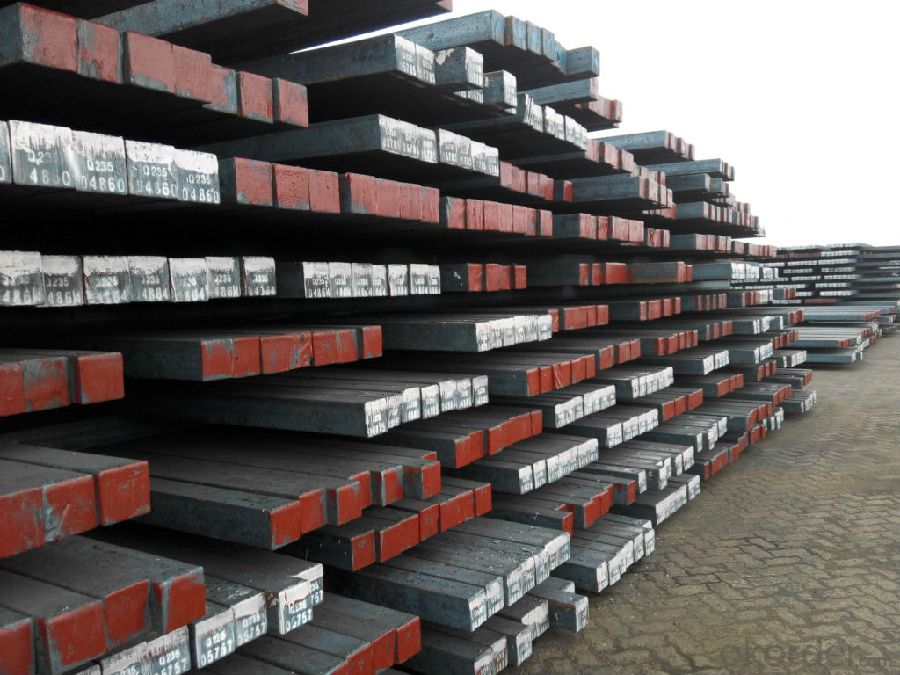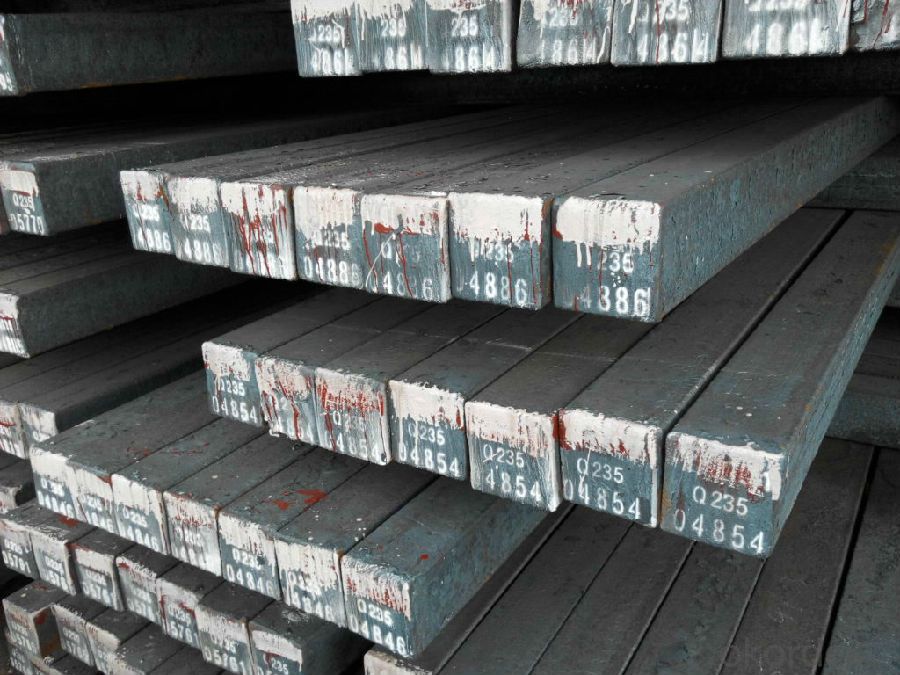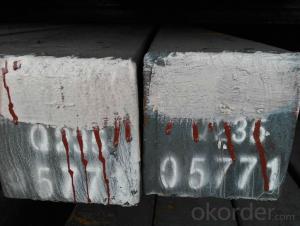Square Billets for construction Hot Sale Deformed Billet
- Loading Port:
- China main port
- Payment Terms:
- TT OR LC
- Min Order Qty:
- 50 m.t.
- Supply Capability:
- 100000 m.t./month
OKorder Service Pledge
OKorder Financial Service
You Might Also Like
Product Description of Square Billets for construction Hot Sale Deformed Billet
| GRADE | SIZE | APPLICATION |
Q195/ 215 | 100mm*100mm*6m | REBAR |
| 120mm*120mm*6m | ||
| 130mm*130mm*6m/12m | ||
| 150mm*150mm*6m/12m |
Chemical Compositon of Square Billets for construction Hot Sale Deformed Billet
Q195/ 215 | C (%) | Si (%) | Mn (%) | P(%) | S(%) |
| 0.06-0.12 | 0.15-0.30 | 0.35-0.50 | 0.045% Max | 0.045Max |
Technology process of Square Billets for construction Hot Sale Deformed Billet
1.Heat the EVA film
2.Cover the heated EVA film on the mould(can be made from wood or aluminum)
3.Spray a coating in a certain baume degree
4.Put on the empty blask
5.Sand-up the flask and vibrate to compaction
Packaging & Delivery of Square Billets for construction Hot Sale Deformed Billet
Packaging Details:containers
Delivery Detail:Complete one set of equipment needs for three months
The products can be delivered by bulk vessel or by container. As for container, products with the length of 6m will be loaded in 20’ container, with 9m or 12m, in 40’ container.
-The maximum quantity of loading of container is 25 tons.
-The products usually are transported to the nearest port from the production place.
Products Show


FAQ:
1.Your advantages?
Professional products inquiry, products knowledge train (for agents), smooth goods delivery, excellent
customer solution proposale
2. Test & Certificate?
SGS test is available, customer inspection before shipping is welcome, third party inspection is no problem
3. Factory or Trading Company?
CNBM is a trading company but we have so many protocol factories and CNBM works as a trading department
of these factories. Also CNBM is the holding company of many factories.
4. Payment Terms?
30% TT as deposit and 70% before delivery.
Irrevocable L/C at sight.
5. Trading Terms?
EXW, FOB, CIF, FFR, CNF
6. After-sale Service?
CNBM provides the services and support you need for every step of our cooperation. We're the business
partner you can trust.
For any problem, please kindly contact us at any your convenient time.
We'll reply you in our first priority within 24 hours.
- Q:What are the main factors affecting the impact toughness of steel billets?
- The main factors affecting the impact toughness of steel billets include the composition of the steel, the heat treatment process, the presence of impurities or defects, the grain size and microstructure, and the temperature at which the impact test is conducted.
- Q:How are steel billets labeled for identification purposes?
- Steel billets are typically labeled for identification purposes through various methods such as stamping or tagging, where important information such as size, grade, heat number, and production date are marked directly on the billet or attached to it. This labeling allows for easy traceability and identification throughout the manufacturing and supply chain processes.
- Q:How are steel billets used in the production of tooling?
- Tooling production relies heavily on the use of steel billets, which are indispensable for creating tools and machinery components. These semi-finished steel products play a vital role in the process due to their exceptional properties. To begin with, the steel billets undergo a transformation process called forging, where they are heated and subjected to pressure to achieve the desired shape and size. This forging process forms the basis for manufacturing a wide range of tooling components, including dies, molds, punches, and cutting tools. The strength and durability of steel billets make them highly suitable for tooling applications. Steel is renowned for its high tensile strength, which allows tools to withstand heavy loads and resist deformation during operation. Additionally, steel billets can be heat-treated to enhance their hardness, toughness, and wear resistance, thereby improving the performance and longevity of the tools. Moreover, steel billets possess excellent machinability, enabling them to be easily cut, drilled, or shaped into intricate designs. This versatility empowers tooling manufacturers to create complex and customized components that meet specific industry requirements. Once the steel billets have been forged and machined into the desired shape, they undergo additional processes such as grinding, polishing, and coating to attain the final tooling product. These finishing processes ensure that the tool's surface is smooth, free from flaws, and resistant to corrosion. In conclusion, steel billets are essential in tooling production due to their strength, durability, and machinability. They serve as the starting point for manufacturing various tooling components used in industries ranging from automotive manufacturing to aerospace. The versatility and reliability of steel billets make them a vital material in ensuring the quality and performance of tools used across diverse applications.
- Q:What are the advantages of using steel billets in the oil and gas industry?
- Using steel billets in the oil and gas industry offers several benefits. Firstly, steel billets are known for their strength and durability. They can withstand extreme temperatures, pressures, and corrosive environments, which are common in the industry. Secondly, steel billets are resistant to corrosion. They are often made from corrosion-resistant alloys or treated with protective coatings, ensuring they can handle corrosive substances and last longer. Thirdly, steel billets are highly versatile. They can be easily shaped into different components, allowing for customization and adaptability to specific projects. Fourthly, steel billets provide excellent safety properties. They are less likely to fail or rupture, reducing the risk of accidents and ensuring personnel and assets are safe. Additionally, although steel billets may have higher upfront costs, their durability and resistance to corrosion result in long-term cost savings. Moreover, steel is widely available and cost-effective to source and produce. Lastly, using steel billets promotes environmental sustainability as steel is highly recyclable. Overall, the advantages of using steel billets in the oil and gas industry contribute to efficient and reliable operations.
- Q:What is a steel billet?
- The process of casting molten steel into a rectangular shape produces a semi-finished product known as a steel billet. This billet usually has a square or rectangular cross-section and serves as the initial material for various steel products. The size of a steel billet varies depending on its intended purpose, typically ranging from 100mm to 200mm square in cross-section and several meters in length. Rolling or extrusion techniques are employed to further process these billets, forming bars, rods, wires, or structural steel sections. Steel billets are extensively utilized in the manufacturing industry as a raw material for the production of diverse steel products used across sectors such as construction, automotive, machinery, and more.
- Q:What are the different forging methods used for steel billets?
- Steel billets can be forged using different methods, each with its own advantages and applications. Open Die Forging is a method where the steel billet is shaped between flat dies. This allows for flexibility in design and size, making it suitable for larger and more complex parts that require customization, like shafts, cylinders, and discs. Closed Die Forging, also known as impression die forging, involves shaping the steel billet within a set of dies that contain the desired shape. It is ideal for producing high-precision and complex parts with tight tolerances, such as gears, connecting rods, and crankshafts. Upset Forging is a method that involves increasing the cross-sectional area of the steel billet by compressing it between dies. This is commonly used for creating short-length parts like bolts, screws, and fasteners. Roll Forging uses cylindrical rolls to gradually shape the steel billet into the desired form. It is often used to produce long parts with a consistent cross-section, such as bars, rods, and shafts. Press Forging utilizes a hydraulic or mechanical press to shape the steel billet, providing greater control over the forging process. This method is often employed for manufacturing automotive components, aerospace parts, and tools. Isothermal Forging involves heating the steel billet and the dies to the same temperature, reducing the cooling effect during forging. This allows for greater control over the microstructure and mechanical properties of the final product, making it suitable for producing parts that require high strength and temperature resistance. Each forging method has its own benefits, allowing steel billets to be shaped into a wide range of products with varying complexity, size, and mechanical properties. The choice of forging method depends on factors such as the desired product, material properties, production volume, and cost considerations.
- Q:What are the main factors affecting the cost of steel billets?
- The cost of steel billets can be influenced by several key factors. 1. Raw material expenses play a significant role in determining the overall cost of steel billets. The prices of iron ore and scrap metal, which are used in the production process, can fluctuate in the global market, causing the cost of steel billets to rise or fall. 2. The cost of manufacturing steel billets includes various production and processing costs. These expenses, such as energy, labor, and maintenance costs, can vary depending on factors like production efficiency, skilled labor availability, and energy source prices. 3. The balance between supply and demand in the steel billet market can heavily impact their cost. If there is high demand and limited supply, prices can increase. Conversely, if there is excess supply and low demand, prices can decrease. 4. The level of competition among steel producers can also affect the cost of steel billets. In a competitive market, prices may be driven down as producers vie for customers. In a less competitive market, producers may have more pricing power, leading to higher prices. 5. Government policies and trade barriers, such as import tariffs and quotas, can influence the cost of steel billets. These measures can either protect domestic producers or create opportunities for cheaper imports, depending on specific policies in place. 6. Fluctuations in currency exchange rates can impact the cost of steel billets. A stronger domestic currency can make imported steel billets cheaper, while a weaker currency can make them more expensive. 7. The cost of transporting steel billets from production facilities to end-users can also affect their overall cost. Factors like distance, transportation mode, and fuel prices can impact transportation expenses, which can, in turn, affect the final price of steel billets. It is important to consider that these factors can interact with each other and their impact on the cost of steel billets can vary based on market conditions and industry dynamics.
- Q:What are the different surface treatments for improved machinability in steel billets?
- To enhance the machinability of steel billets, there are multiple surface treatments available. These treatments aim to optimize cutting performance and minimize tool wear during machining operations. Here are some common methods used to improve machinability in steel billets: 1. Nitriding: Nitriding is a surface hardening treatment that utilizes nitrogen to form a durable and wear-resistant layer on the steel billet's surface. By undergoing this treatment, the cutting performance is enhanced, and tool wear during machining is reduced. 2. Carburizing: Carburizing is a process that involves infusing carbon into the surface of the steel billet to increase its hardness and wear resistance. This treatment improves machinability by creating a harder surface layer capable of withstanding higher cutting speeds and loads. 3. Coating: The application of various coatings on the surface of steel billets can decrease friction and enhance machinability. Examples of such coatings include titanium nitride (TiN) and diamond-like carbon (DLC) coatings. These coatings minimize tool wear and improve cutting performance. 4. Shot peening: Shot peening is a surface treatment that entails bombarding the steel billet's surface with small spherical particles. This treatment induces compressive stress, enhancing fatigue resistance and decreasing the likelihood of crack initiation during machining. 5. Cold working: Cold working involves deforming the steel billet at room temperature to increase its hardness and improve machinability. Cold rolling or cold drawing are processes commonly employed to achieve this treatment. It is crucial to bear in mind that the selection of a surface treatment for improved machinability in steel billets depends on various factors, including the specific steel alloy, desired surface properties, and intended machining process. Consequently, it is essential to consider these factors and seek expert advice to determine the most suitable surface treatment for a particular application.
- Q:How are steel billets used in the manufacturing of fasteners and fittings?
- Steel billets are an essential raw material in the manufacturing of fasteners and fittings. Fasteners, such as bolts, screws, and nuts, are used to hold two or more components together securely. Fittings, on the other hand, are used to connect or join different parts of a structure or system. To manufacture fasteners and fittings, steel billets undergo several processes. Initially, the billets are heated to a high temperature to make them malleable. This heating process, known as hot rolling, allows the steel billets to be shaped into the desired form. The billets are then passed through a series of rollers, which gradually reduce their thickness and increase their length. This process transforms the billets into long, slender rods known as wire rods. The wire rods are subsequently cold drawn or cold rolled to further refine their shape and dimensions. This process improves the surface finish and increases the strength of the rods. The cold drawing or rolling process results in the formation of wires with precise diameters, which are then used to manufacture fasteners such as screws, bolts, and nuts. The wires are cut into specific lengths and threaded to create the necessary grooves and patterns required for fastening. The threads on the wires allow them to be easily screwed into or onto other components, providing a secure and reliable connection. The shape and size of the threads are crucial as they determine the compatibility of the fasteners with different applications. For fittings, the wire rods are subjected to additional processes such as machining, bending, or welding. Machining involves cutting the wire rods into specific shapes and sizes using various cutting tools. Bending allows the wire rods to be shaped into different angles or curves to fit the desired configuration of the fittings. Welding is employed to join multiple wire rods or other components together to create complex fittings. Once the fasteners and fittings are manufactured, they undergo quality control tests to ensure they meet the required standards for strength, durability, and dimensional accuracy. These tests include checking for proper threading, hardness, and resistance to corrosion. In summary, steel billets are extensively used in the manufacturing of fasteners and fittings. Through processes like hot rolling, cold drawing or rolling, threading, and various shaping techniques, steel billets are transformed into wires and then further processed to create a wide range of fasteners and fittings that are crucial for construction, machinery, automotive, and other industries.
- Q:What are the different heat treatment processes applied to steel billets?
- Steel billets can undergo various heat treatment processes to achieve specific properties and characteristics in the final product. Common processes include: 1. Annealing: Steel billets are heated to high temperatures and then slowly cooled, often in a controlled atmosphere or furnace. This relieves internal stresses, enhances machinability, and improves ductility and toughness. 2. Normalizing: Steel billets are heated above the critical range and then air-cooled. This process refines the grain structure, improves mechanical properties, and enhances machinability. 3. Quenching: Steel billets are rapidly cooled by immersing them in a quenching medium (e.g., water, oil, or polymer) after being heated to high temperatures. This creates a hardened and stronger steel with improved wear resistance, but brittleness may increase. 4. Tempering: After quenching, hardened steel billets are reheated to a specific temperature and then cooled in still air. Tempering relieves residual stresses, reduces brittleness, and improves toughness and ductility. 5. Austempering: Steel billets are quenched in a molten salt bath or another medium just above the critical range and held at that temperature until the desired transformation occurs. Austempering results in high strength, improved ductility, and reduced distortion. 6. Martempering: Similar to austempering, martempering involves a shorter holding time at the quenching temperature. This process produces a steel with high strength, toughness, and reduced distortion. 7. Case hardening: Carbon is added to the surface layer of steel billets through carburizing or nitriding. This forms a hardened case with increased wear resistance while maintaining a more ductile core. These examples illustrate some of the heat treatment processes applicable to steel billets. The specific process chosen depends on the desired properties of the final product and the type of steel being treated.
1. Manufacturer Overview |
|
|---|---|
| Location | |
| Year Established | |
| Annual Output Value | |
| Main Markets | |
| Company Certifications | |
2. Manufacturer Certificates |
|
|---|---|
| a) Certification Name | |
| Range | |
| Reference | |
| Validity Period | |
3. Manufacturer Capability |
|
|---|---|
| a)Trade Capacity | |
| Nearest Port | |
| Export Percentage | |
| No.of Employees in Trade Department | |
| Language Spoken: | |
| b)Factory Information | |
| Factory Size: | |
| No. of Production Lines | |
| Contract Manufacturing | |
| Product Price Range | |
Send your message to us
Square Billets for construction Hot Sale Deformed Billet
- Loading Port:
- China main port
- Payment Terms:
- TT OR LC
- Min Order Qty:
- 50 m.t.
- Supply Capability:
- 100000 m.t./month
OKorder Service Pledge
OKorder Financial Service
Similar products
New products
Hot products
Hot Searches
Related keywords






























